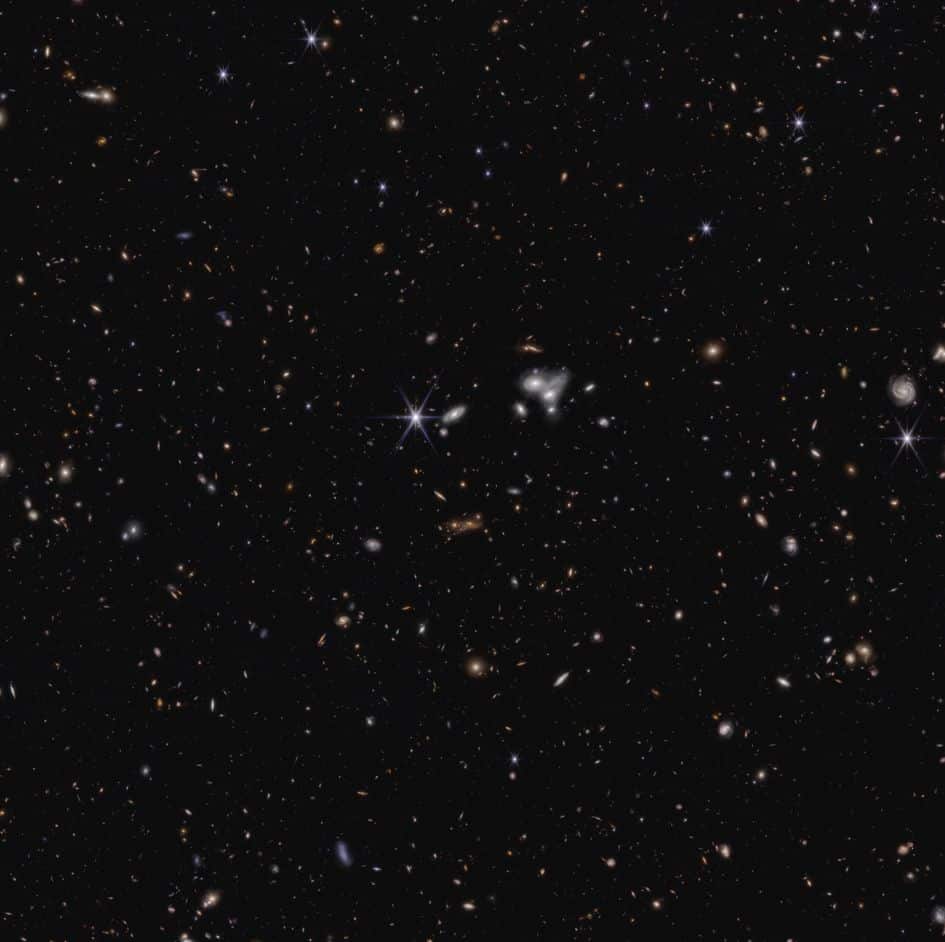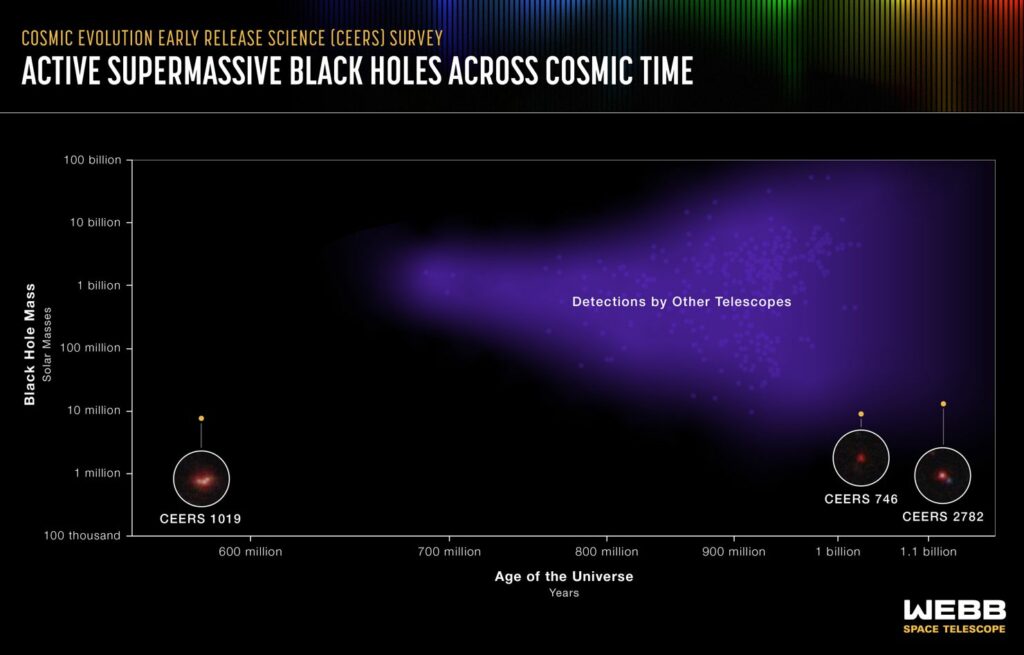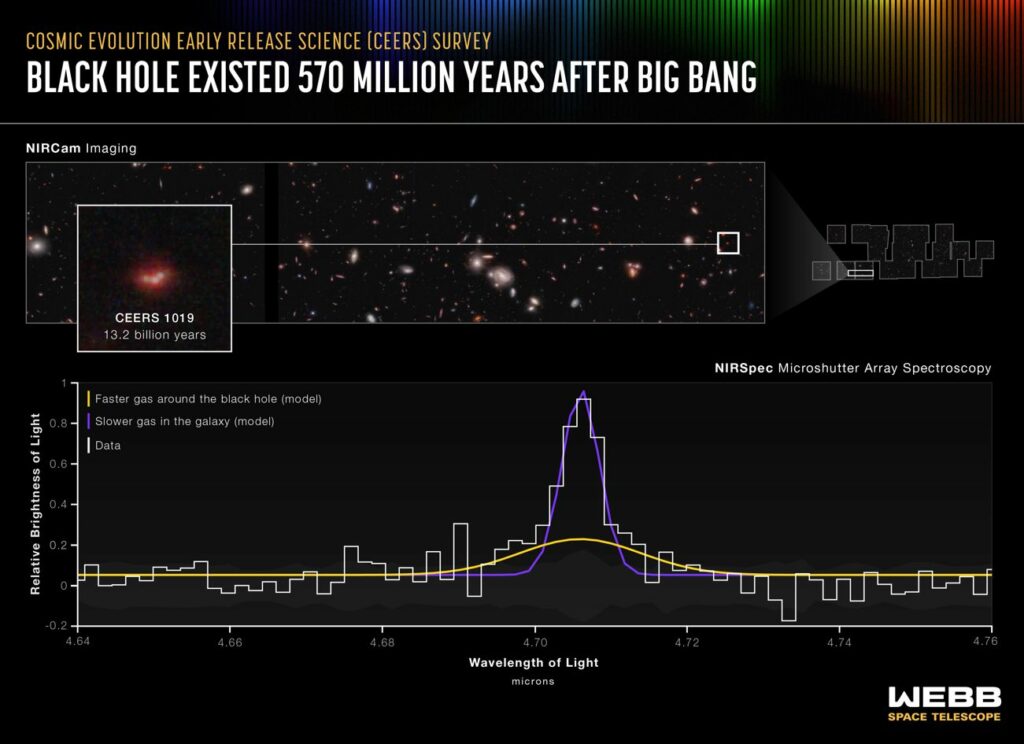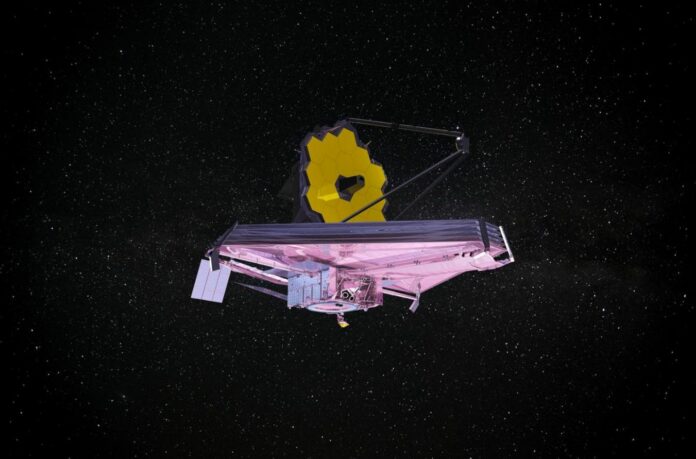Astronomers claim to have found the most distant active supermassive black hole to date existed about 570 million years after the big bang.
The James Webb Space Telescope (JWST) has made a groundbreaking discovery by detecting the most distant active supermassive black hole known to date. Through the Cosmic Evolution Early Release Science (CEERS) Survey led by Professor Steven Finkelstein from The University of Texas at Austin, the researchers used JWST’s advanced near- and mid-infrared imaging capabilities and spectral data to identify significant celestial phenomena.
One remarkable finding is the galaxy CEERS 1019, which existed approximately 570 million years after the big bang. Within this galaxy, the researchers detected a black hole that is smaller in mass compared to any other black hole identified in the early universe. Additionally, two relatively smaller black holes were identified, which existed 1 billion and 1.1 billion years after the big bang.
Furthermore, JWST unveiled eleven galaxies that were present between 470 million to 675 million years after the big bang. The detailed evidence gathered from JWST’s observations provided invaluable insights into the early universe.
These significant findings were made possible through JWST’s Cosmic Evolution Early Release Science (CEERS) Survey, led by Professor Steven Finkelstein from The University of Texas at Austin. The survey utilized the telescope’s highly detailed near- and mid-infrared images and spectroscopic data to uncover these discoveries.
“Looking at this distant object with this telescope is a lot like looking at data from black holes that exist in galaxies near our own,” remarked Rebecca Larson. “There are so many spectral lines to analyze!”

The team has published their findings in several initial papers featured in a special edition of The Astrophysical Journal Letters.
CEERS 1019 stands out not only due to its early existence but also because of the relatively lower mass of its black hole. Weighing in at around 9 million solar masses, this black hole is significantly lighter than others observed in the early universe using different telescopes. Those massive black holes typically exceed 1 billion times the mass of the sun and are more easily detectable due to their higher brightness. The black hole in CEERS 1019 more closely resembles the one located at the center of our Milky Way galaxy, which has a mass of 4.6 million solar masses.
Despite its smaller size, the presence of this black hole at such an early stage poses a challenge in explaining how it formed shortly after the beginning of the universe. Scientists have long suspected the existence of smaller black holes in the early universe, but definitive detections were only made possible through the observations of the JWST.

The team not only managed to disentangle the emissions from the black hole and its host galaxy in the spectrum but also determined the amount of gas being consumed by the black hole and the star-formation rate of its galaxy. They discovered that this galaxy is ingesting gas at its maximum capacity while simultaneously producing new stars. To gain insights into this phenomenon, the researchers turned to the images, which revealed that CEERS 1019 appears as three bright clumps rather than a single circular disk.
“We’re not used to seeing so much structure in images at these distances,” commented CEERS team member Jeyhan Kartaltepe, an associate professor of astronomy at the Rochester Institute of Technology in New York. “A galaxy merger could be partly responsible for fueling the activity in this galaxy’s black hole, and that could also lead to increased star formation.”
The Most Distant Black Holes and Galaxies
Exploring further with the CEERS Survey led to the discovery of additional remarkably distant black holes and galaxies. Dale Kocevski from Colby College in Waterville, Maine, and the research team swiftly identified another pair of smaller black holes in the data.
The first one, located in the galaxy CEERS 2782, was easily discernible without any dust obstructing the JWST’s view. Consequently, researchers promptly determined that this black hole existed only 1.1 billion years after the big bang. The second black hole, situated in galaxy CEERS 746, came into being slightly earlier, at 1 billion years after the big bang. However, its bright accretion disk, which is composed of gas and dust encircling the supermassive black hole, remains partially obscured by dust.

“The central black hole is visible, but the presence of dust suggests it might lie within a galaxy that is also furiously pumping out stars,” Kocevski added.
Similar to the black hole in CEERS 1019, these two newly discovered black holes in galaxies CEERS 2782 and CEERS 746 are also considered relatively lightweight compared to previously known supermassive black holes at such distances. They have a mass of approximately 10 million times that of the sun.
“Researchers have long known that there must be lower mass black holes in the early universe. Webb is the first observatory that can capture them so clearly,” Kocevski added. “Now we think that lower mass black holes might be all over the place, waiting to be discovered.”
Prior to the JWST, all three black holes were too faint to be detected, appearing as ordinary galaxies undergoing star formation when observed using other telescopes.
Additionally, the sensitive spectra of JWST allowed the researchers to precisely measure the distances and ages of galaxies in the early universe. Pablo Arrabal Haro from the National Science Foundation’s NOIRLab and Seiji Fujimoto, a postdoctoral researcher and Hubble fellow at UT Austin, identified 11 galaxies that existed between 470 million and 675 million years after the big bang. Not only are these galaxies situated at incredibly remote distances, but the fact that numerous bright galaxies were detected is also remarkable. The observations challenge previous theories that anticipated fewer galaxies at these distances with the JWST.
“I am overwhelmed by the amount of highly detailed spectra of remote galaxies Webb returned,” Arrabal Haro remarked. “These data are absolutely incredible.”
These galaxies are undergoing rapid star formation but have not yet attained the same level of chemical enrichment as galaxies closer to our own.
“Webb was the first to detect some of these galaxies,” Fujimoto added. “This set, along with other distant galaxies we may identify in the future, might change our understanding of star formation and galaxy evolution throughout cosmic history.”
These initial findings from the CEERS Survey represent a significant breakthrough. Previously, research on objects in the early universe relied mostly on theoretical models. However, with the JWST, scientists can now observe black holes and galaxies at extraordinary distances and precisely measure their properties. This telescope holds tremendous power for advancing our understanding of the cosmos.
In the future, JWST’s data may contribute to unraveling the formation process of early black holes, potentially revising existing models of their growth and evolution during the initial hundreds of millions of years of the universe’s history.
The James Webb Space Telescope is an international program jointly led by NASA, the European Space Agency, and the Canadian Space Agency.
Image Credit: NASA, ESA, CSA, STEVE FINKELSTEIN (UT AUSTIN), MICAELA BAGLEY (UT AUSTIN), REBECCA LARSON (UT AUSTIN).
